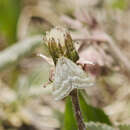fi
nimet breadcrumb-navigoinnissa


Pyrausta unifascialis, the one-banded pyrausta, is a moth in the family Crambidae. It was described by Alpheus Spring Packard in 1873.[1] It is found in North America, where it has been recorded from Quebec west to British Columbia, south to Arizona and California.[2] The habitat consists of forest openings, clearings and fields.
The wingspan is 16–24 mm.[3] The forewings are brown with scattered black scales and a whitish S-shaped band in the subterminal area. The hindwings are dark grey with a white triangular discal patch. Adults are on wing from April to August.
The larvae are polyphagous. They have been recorded feeding on Antennaria, Phaseolus, Eriogonum and Gayophytum species.[4]
Pyrausta unifascialis, the one-banded pyrausta, is a moth in the family Crambidae. It was described by Alpheus Spring Packard in 1873. It is found in North America, where it has been recorded from Quebec west to British Columbia, south to Arizona and California. The habitat consists of forest openings, clearings and fields.
The wingspan is 16–24 mm. The forewings are brown with scattered black scales and a whitish S-shaped band in the subterminal area. The hindwings are dark grey with a white triangular discal patch. Adults are on wing from April to August.
The larvae are polyphagous. They have been recorded feeding on Antennaria, Phaseolus, Eriogonum and Gayophytum species.
Pyrausta unifascialis is een vlinder uit de familie van de grasmotten (Crambidae).[1] De wetenschappelijke naam van de soort is voor het eerst geldig gepubliceerd in 1873 door Packard.
Bronnen, noten en/of referentiesPyrausta unifascialis là một loài bướm đêm trong họ Crambidae.[1][2]